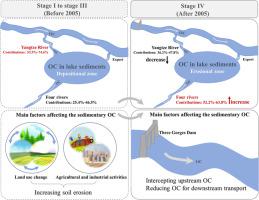当前位置:
X-MOL 学术
›
Water Res.
›
论文详情
Our official English website, www.x-mol.net, welcomes your feedback! (Note: you will need to create a separate account there.)
Coupled effects of human activities and river–Lake interactions evolution alter sources and fate of sedimentary organic carbon in a typical river–Lake system
Water Research ( IF 12.8 ) Pub Date : 2024-03-23 , DOI: 10.1016/j.watres.2024.121509 Shilan Wang , Fengwei Ran , Zhongwu Li , Changrong Yang , Tao Xiao , Yaojun Liu , Xiaodong Nie
Water Research ( IF 12.8 ) Pub Date : 2024-03-23 , DOI: 10.1016/j.watres.2024.121509 Shilan Wang , Fengwei Ran , Zhongwu Li , Changrong Yang , Tao Xiao , Yaojun Liu , Xiaodong Nie

|
Interconnected river–lake systems record sedimentary organic carbon (OC) dynamics and watershed environmental changes, providing valuable information for global carbon budgets and watershed management. However, owing to the evolving river–lake interactions under global change, monitoring OC is difficult, thereby impeding the understanding of OC transport and fate. This study provided new insights into the dynamical mechanisms of OC in a typical river–lake system consisting of Dongting Lake and its seven inlet/outlet rivers (the three inlets of the Yangtze River and four tributaries) over the last century using stable isotope tracing and quantified the influences of climate change and human activities on OC. Results indicated that exogenous OC dominated the OC in the lake (58.2 %–89.0 %) and was lower in the west than in the east due to the differences in the material inputs and depositional conditions within the lake. Temporally, the distribution patterns of OC sources mainly responded to human activities in the basin rather than to climate change. Before 2005, the Yangtze River contributed the most OC (53.5 %–74.6 %), attributed to the high-intensity land use changes (path coefficient (r): 0.48, p-value < 0.01) and agriculture-industry activities (r: 0.44, p-value < 0.001) in the Yangtze River basin that increased soil erosion. After 2005, a large amount of Yangtze River OC was intercepted by the Three Gorges Dam, altering the OC exchange in the river–lake system and shifting OC dominance to the four tributaries (52.2 %–63.8 %). These findings highlight the active response of OC to the river–lake interaction evolution and anthropogenic control, providing critical information for regulating watershed management behavior under global change.
中文翻译:

人类活动和河湖相互作用演化的耦合效应改变了典型河湖系统中沉积有机碳的来源和命运
相互连接的河湖系统记录了沉积有机碳(OC)动态和流域环境变化,为全球碳预算和流域管理提供了有价值的信息。然而,由于全球变化下不断变化的河湖相互作用,监测有机碳非常困难,从而阻碍了对有机碳迁移和归宿的理解。这项研究利用稳定同位素示踪和分析方法,为上个世纪由洞庭湖及其七个入/出江河(长江的三个入口和四个支流)组成的典型河湖系统中有机碳的动力学机制提供了新的见解。量化了气候变化和人类活动对OC的影响。结果表明,湖内OC以外源OC为主(58.2%~89.0%),且由于湖内物质输入和沉积条件的差异,西部低于东部。从时间上看,OC源的分布格局主要响应流域内的人类活动,而不是气候变化。 2005年之前,由于高强度的土地利用变化(路径系数(r):0.48,p值<0.01)和农业工业活动(r: 0.44,p值<0.001)在长江流域土壤侵蚀加剧。 2005年以后,长江大量有机碳被三峡大坝截流,改变了江湖体系中有机碳的交换,有机碳的主导地位向四大支流转移(52.2%~63.8%)。这些发现凸显了OC对河湖相互作用演化和人为控制的积极响应,为调节全球变化下的流域管理行为提供了关键信息。
更新日期:2024-03-23
中文翻译:

人类活动和河湖相互作用演化的耦合效应改变了典型河湖系统中沉积有机碳的来源和命运
相互连接的河湖系统记录了沉积有机碳(OC)动态和流域环境变化,为全球碳预算和流域管理提供了有价值的信息。然而,由于全球变化下不断变化的河湖相互作用,监测有机碳非常困难,从而阻碍了对有机碳迁移和归宿的理解。这项研究利用稳定同位素示踪和分析方法,为上个世纪由洞庭湖及其七个入/出江河(长江的三个入口和四个支流)组成的典型河湖系统中有机碳的动力学机制提供了新的见解。量化了气候变化和人类活动对OC的影响。结果表明,湖内OC以外源OC为主(58.2%~89.0%),且由于湖内物质输入和沉积条件的差异,西部低于东部。从时间上看,OC源的分布格局主要响应流域内的人类活动,而不是气候变化。 2005年之前,由于高强度的土地利用变化(路径系数(r):0.48,p值<0.01)和农业工业活动(r: 0.44,p值<0.001)在长江流域土壤侵蚀加剧。 2005年以后,长江大量有机碳被三峡大坝截流,改变了江湖体系中有机碳的交换,有机碳的主导地位向四大支流转移(52.2%~63.8%)。这些发现凸显了OC对河湖相互作用演化和人为控制的积极响应,为调节全球变化下的流域管理行为提供了关键信息。



























 京公网安备 11010802027423号
京公网安备 11010802027423号